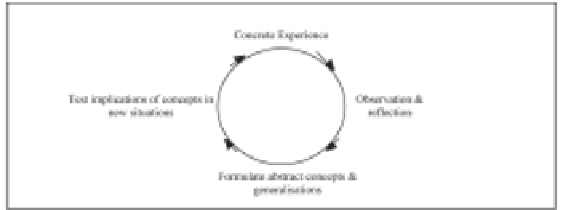Information Technology Reference
In-Depth Information
Reflection
This paper refers to Dewey's (1997) method of thinking and problem solving - reflection
that involves the spontaneous creation of a belief (Dewey, 1997), conjecture (Popper,
1969) or intuition (Georgiou, 2001) from one's consciousness and past experience, con-
templating and pondering these thoughts, comparing them with an ideal, and finally
challenging them in an attempt to substantiate or invalidate them.
Dewey (1997) expresses this reflection succinctly:
Active, persistent and careful consideration of any belief or supposed form of
knowledge in the light of the grounds that support it, and the further conclu-
sions to which it tends, constitutes reflective thought. (p6)
The continuous cycle of experiencing, reflecting, forming possible solutions, and testing
is illustrated in Kolb's model (see Figure 9.1) as depicted in Graeff (1997). Kolb (1984)
argues that, rather than viewing experiential learning as a closed cycle, it should be
seen as a spiral 'filling each episode of experience with the potential for movement, from
blind impulse to a life of choice and purpose.'
Figure 9.1. Kolb's model of reflection.
Reflective learning 'engages the person at the edge of their knowledge, their sense of
self and the world as experienced by them' (Brockbank and McGill, 1998) where their
ideas, beliefs or knowledge are challenged.
Reflection types
Simple reflection
Simple or single-loop reflection refers to increasing efficiency of an objective; 'Are we
doing things right?' (Flood and Romm, 1996) - it is task oriented and is about the design
of the process to retain reliability. It is simple reflection that may challenge assumptions
and strategies to alter the plan of action but always 'in ways that leave the values of a
theory of action unchanged' (Brockbank and McGill, 1998). Courtney et al. (1998) describe
this as low-level as it involves keeping to a set of rules and is simply error correction.
This reflection and learning are viewed as valuable for day-to-day activities and are
necessary for progress to be made within the established frameworks (Brockbank and
McGill, 1998). To illustrate this sort of reflection, Dooley (1999) uses the example of a
buggy whip manufacturer in the early 21st century improving the manufacturing process
in order to make finer buggy whips. The manufacturer does not look beyond his imme-
diate task to take in the strategic perspective of, for example, the long term viability of
buggy whip manufacturing. Similarly, an organisation may upgrade a transaction pro-
cessing system to handle processes more efficiently without the effectiveness or even
necessity of the processes being examined.

Search WWH ::

Custom Search